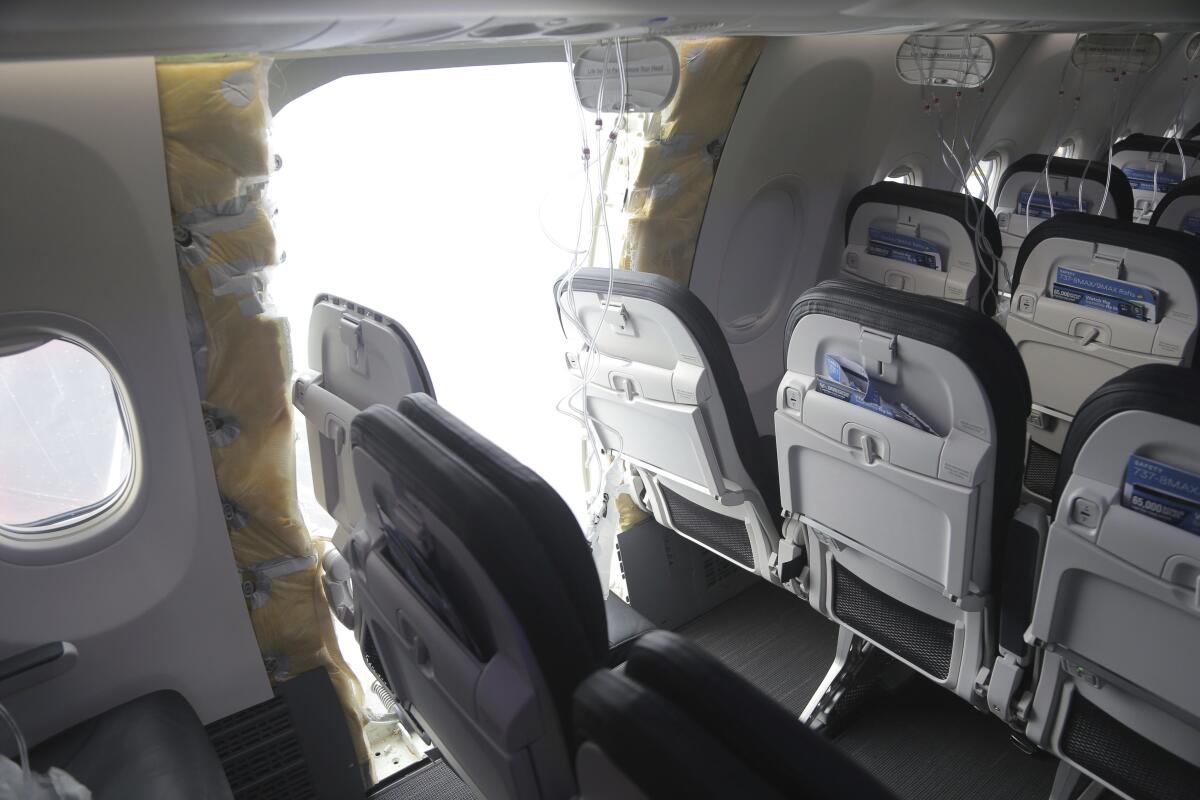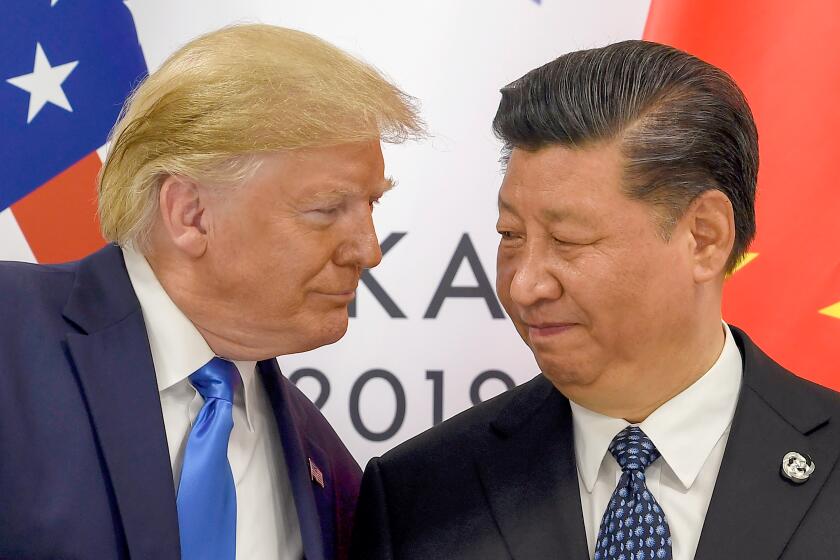Trump fired a tariff torpedo at China — and hit Boeing right between the eyes

- Share via
We keep hearing about all the goods that will become more expensive for Americans thanks to Donald Trump’s tariff policy, such as it is: clothing, shoes, cars, food, especially anything imported from China.
But the latest skirmish between Trump and China has painted a target on this nation’s most important manufacturing exporter: Boeing Co.
On Tuesday, news emerged that Chinese authorities have ordered the country’s airlines not to place new orders for Boeing aircraft and to get approval from the government before taking delivery of planes already ordered.
This is a tariff policy we’ve been told will solve the fentanyl crisis, get rid of illegal immigration, rescue the budget deficit, solve bilateral trade deficits and cure toe fungus....Actually we’re serving none of those goals.
— Economist Justin Wolfers
The size of the blow China struck against Boeing is hard to measure, especially in the short term. Industry analysts calculate China’s orders to amount to 5% to 6% of the company’s overall international order book. But Boeing is the biggest exporter in the U.S., and about 80% of its production goes overseas.
That makes Boeing especially vulnerable to all the chaos created by Trump’s tariff war. Earlier this week, Michael O’Leary, the chief executive of the Ireland-based low-cost airline Ryanair, said the tariffs might prompt his company to defer taking delivery of 25 Boeing airliners until sometime next year, instead of in August.
Get the latest from Michael Hiltzik
Commentary on economics and more from a Pulitzer Prize winner.
You may occasionally receive promotional content from the Los Angeles Times.
The Chinese ban plainly hit Trump in the solar plexus. After the ban was reported Tuesday, Trump took to his social media platform, Truth Social, to grouse that China “just reneged on the big Boeing deal, saying that they will ‘not take possession’ of fully committed to aircraft.”
If that’s so, Trump has no one to blame but himself. Boeing’s plight is just one aspect of a White House tariff policy that increasingly resembles, as Shakespeare might have put it, “a tale told by an idiot, full of sound and fury, signifying nothing.”
A more contemporary judgment is that of economist Justin Wolfers of the University of Michigan, who on Tuesday put his finger on the fundamental incoherence of Trump’s policy:
“This is a tariff policy we’ve been told will solve the fentanyl crisis, get rid of illegal immigration, rescue the budget deficit, solve bilateral trade deficits and cure toe fungus,” Wolfers said on MSNBC. “All of these things can’t happen at once and in the way they’re pursuing them, actually we’re serving none of those goals.”
In many previous downturns, it was easier to base one’s view of the future on stock market patterns of the past. Not this time.
To take just a couple of those goals Wolfers enumerated — reducing the budget deficit and shrinking bilateral trade deficits — neither can be achieved by prompting trading partners to shut down or defer purchases from a domestic exporter as weighty as Boeing.
Nor is Boeing the only major manufacturer affected by the trade war. Shares in the AI chipmaker Nvidia fell nearly 7% on Wednesday after it disclosed a $5.5-billion charge linked to U.S. restrictions on export sales of its H20 chips.
The long-term cost of any Chinese roadblock on Boeing can’t be predicted just yet. Boeing has declined to comment on China’s decision and Chinese authorities have remained mum. Stock traders punished Boeing shares Tuesday, sending them down by nearly 2.4%, but the shares recovered modestly in Wednesday’s trading, up 0.77% at the close.
Boeing and its followers on Wall Street have largely taken a sanguine view of the Chinese decree. Boeing has an enormous backlog of 5,000 orders, company Chief Financial Officer Brian West told an investment conference last month. Aircraft that have been due for Chinese deliveries can be redirected to customers that are currently waiting in line for theirs.
But the dispute can’t help but hobble Boeing’s efforts to compete with the European consortium Airbus, which already has a leg up over Boeing in the China market. China is the biggest customer of Airbus, which is scheduled to deliver 136 planes to China this year, 148 next year and a total of 850 over the coming decade.
By contrast, Boeing’s book of unfilled Chinese orders numbers only 130, mostly of 737 Max airliners. The company says it delivered 18 planes to China’s domestic airlines and other Chinese customers through March; market observers estimate that an additional 26 aircraft have been scheduled for delivery during the rest of this year.
Hiltzik: Did business leaders do enough to head off Trump’s tariff saber-rattling? Obviously not
Business leaders wrung their hands over the prospect of a tariff war started by Trump, but they didn’t take a strong enough stand
China ceased ordering Boeing planes in 2018 after ordering 927 planes from 2010 through 2017. It didn’t resume orders until 2020, when it contracted for five aircraft — two for a domestic cargo airline and three for a leasing company. It placed no orders again in 2022, only one (to a leasing company) in 2023, and none again last year or so far this year.
That’s a painful record, given that Boeing’s own market projection identifies China as the largest customer for commercial aircraft in the world, outside the U.S., over the next two decades, accounting for about 20% of global demand. That makes it a market from which Boeing can’t afford to be shut out.
There can be no gainsaying that Boeing has been in a bad way at least since 2018, the last year in which the company booked an annual profit. Over the subsequent six years, it lost $35.7 billion on revenue of $408 billion. Boeing’s financial results for the first quarter of 2025 will be released April 23.
The company also has been hemorrhaging cash — burning through $14.3 billion last year. Management says the cash burn will continue through part of this year but turn positive later in 2025.
Boeing’s string of losses stemmed in part from a series of operational and engineering disasters, notably the two crashes of its 737 Max passenger planes in 2018 and 2019, which took 346 lives. The crashes resulted in a grounding of the aircraft that was only lifted in late 2020, as well as fines, penalties and compensation payments the company has estimated at $20 billion.
Boeing’s reputation for quality and safety took another hit in January 2024 when a fuselage panel on a new 737 Max operated by Alaska Airlines blew out in mid-flight. Another grounding of the aircraft followed.
A further blow came in September, when its Starliner spacecraft was judged so faulty that NASA refused to allow it to transport two astronauts home from the International Space Station. The craft had to return to Earth without passengers. The astronauts were finally brought home last month aboard a SpaceX Dragon spacecraft after spending 286 days in space.
Trump proclaimed his 2020 trade deal with China to be “transformative.” It turned out to be an expensive flop.
These events opened a window on Boeing’s greater malady, the collapse of its traditions of superb engineering and rigorous quality control and the company’s conversion into a finance-oriented behemoth that, as it happened, made neither profits nor trustworthy products.
The roots of Boeing’s transformation could be found in its 1997 acquisition of McDonnell Douglas. That deal brought to the C-suite the acquired company’s top management and its cost-cutting culture; in the Boeing corridors, the standing joke was that “McDonnell Douglas bought Boeing with Boeing’s money.”
In 2001, Boeing moved its headquarters from Seattle, where it was founded in 1916, to Chicago, prompted largely by tens of millions of dollars in tax abatements and other benefits. The move put 2,100 miles between headquarters and the company’s most important segment, commercial aircraft, which remained in Seattle.
Another misstep was the decision to farm out the design and manufacture of crucial components for its 787 Dreamliner to suppliers around the nation and in foreign countries such as Italy, Sweden, China, and South Korea. Boeing’s dream was to save money. The reality is that it would have been cheaper to keep a lot of this work in-house.
The 787 ended up with more foreign-made content — 30% — than any other Boeing plane, according to the Society of Professional Engineering Employees in Aerospace, the union representing Boeing engineers. That compared with just over 5% in the company’s workhorse 747 airliner.
But some of the pieces manufactured by far-flung suppliers didn’t fit together. Some subcontractors couldn’t meet their output quotas, creating huge production logjams when crucial parts weren’t available in the necessary sequence. The next-generation airliner was billions of dollars over budget and three years late.
A favorite investment adage says that when a situation is “unsustainable,” it won’t be sustained. Trump’s tariff war looks unsustainable on two fronts.
It makes absolutely no sense as an economic policy; even if one believes that tariffs, surgically applied, can redress imbalances in trade relations, economists almost universally agree that the way this administration has gone about them obliterates any possible gains.
Then there’s the unsustainable impact on American manufacturers, who are the putative beneficiaries of this war, not to mention on American consumers. Someone has to blink, and the record shows it’s mostly likely to be Trump. It’s about time that he did.
More to Read
Insights
L.A. Times Insights delivers AI-generated analysis on Voices content to offer all points of view. Insights does not appear on any news articles.
Viewpoint
Perspectives
The following AI-generated content is powered by Perplexity. The Los Angeles Times editorial staff does not create or edit the content.
Ideas expressed in the piece
- China’s directive to halt Boeing jet orders and deliveries is a direct response to escalating U.S. tariffs, with retaliatory measures raising costs of American aircraft by over 125%[1][2]. This move targets Boeing, a cornerstone of U.S. manufacturing, exacerbating its existing challenges, including a $35.7 billion loss since 2018 and reputational damage from safety crises[1][3].
- Analysts argue Trump’s tariff policy lacks coherence, failing to address stated goals like reducing trade deficits or strengthening the economy. Instead, it injects uncertainty, harming exporters like Boeing and risking global supply chain disruptions[4][5]. Economist Justin Wolfers criticized the policy as economically nonsensical, noting it simultaneously claims to solve disparate issues like immigration and budget deficits without clear mechanisms[1][4].
- Boeing’s long-term competitiveness is at risk, as China—projected to account for 20% of global jet demand—shifts toward Airbus. While Boeing could redirect 2025 orders to markets like India, prolonged exclusion from China may grant Airbus a structural advantage[1][3].
Different views on the topic
- Some industry analysts downplay the immediate impact, citing Boeing’s 5,000-order backlog and ability to reallocate planes to other markets. Bank of America highlighted India as a potential destination for jets initially intended for China, mitigating short-term losses[1][3].
- Trump and supporters frame the tariffs as strategic leverage, with the White House suggesting the moves are part of a broader negotiation tactic. Former officials and allies, like Treasury Secretary Scott Bessent, claim the approach creates “maximum negotiating leverage,” though no concrete deals have materialized[4][5].
- Critics of China’s retaliation argue its aviation sector lacks alternatives to Boeing and Airbus, making the ban unsustainable. Boeing’s dominance in global aircraft production and China’s reliance on foreign jets could force a eventual compromise[1][3].
Get the latest from Michael Hiltzik
Commentary on economics and more from a Pulitzer Prize winner.
You may occasionally receive promotional content from the Los Angeles Times.














